« September 2010 |
Main
| November 2010 »
 October 28, 2010 | Fifths, Symmetry and You: Perceptual Economy
October 28, 2010 | Fifths, Symmetry and You: Perceptual Economy
This week's Tips article is another terrific entry from staff contributor and music software theory Guru, Craig Schmoller, and a timely third part to our "Geometry" Trilogy. By now, you should already be familiar with his Mando ModeExplorer , one of the most authoritative and concise fretboard software programs available for mandolin, and his recently released Jazz CitternExplorer, an invaluable resource for anyone wanting to dive deeper into 5-string fifths tuned instruments.
Check them out again:
Jazz CitternExplorer
Mando ModeExplorer
"According to Gestalt theory, the perceptual system works on economic principles and tends to reach the maximum efficiency (i.e., increase of quality, goodness, and accuracy) with minimum invested energy (i.e., reduction of processing load)." - informaworld.com abstract of "Symmetry, complexity and perceptual economy" by Markovicacut and Gvozdenovi
Simple is way better.

Because you see two happy mandolins in the inkblot, we can conclude you are happy, talented, and well-adjusted. We can also conclude that every time you walk by that thing, you feel compelled to pick it up and play. The thing is addicting. But a big part of the reason why the mandolin consumes our free time the way it does is because of the elegance and symmetry, and simplicity of Fifths Tuning.
From time to time I have heard a mandolin player say, "I don't get this 'symmetry' thing everyone talks about. What symmetry?" And our poor guitar playing cousins with that weird fourths-with-a-major-third-speed-bump Standard Guitar Tuning really don't know what they're missing. The symmetry, once you see it, makes things simple. Psychologists have long known that a simple, repeating, predictable pattern makes things easy for us humans to deal with. And the mandolin is one big predictable pattern!
Let's take a look at some of the enormous symmetrical advantages of Fifths Tuning
Visualizing Patterns: Perceptual Economy
One of the most important things we can do to get the most out of a mandolin, or any fifths-tuned instrument, is to find the intervals of the major scale (w-w-h-w-w-w-h) and see how the relationships lay out on the neck. The beauty of the consistent fifths (as opposed to other tunings) is in the symmetries you find on the instrument. The major scale, for example, produces a nice compact symmetry that makes complete visualization and navigation of the instrument a snap. Let's call this the "Playing Field."
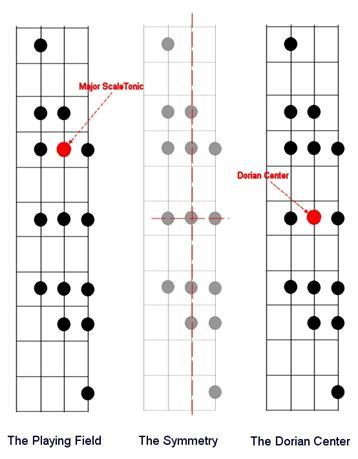
Our playing field represents notes of the major scale spread out over a couple octaves. We find that there is a simple, easy-to-navigate, symmetrical pattern that emerges. It's the same from top to bottom, left to right.
The symmetry is actually discovered on the second degree of the major scale (marked as the "Dorian Center) which is the tonic of the dorian mode (the ii of the major scale).
So how did this happen? Why is it so easy to see this simple, predictable, memorable pattern on the mandolin? Well, that goes back to how the major scale works. Look for example, at a keyboard. You'll notice that from D upward, you see a mirror-image of D going down:
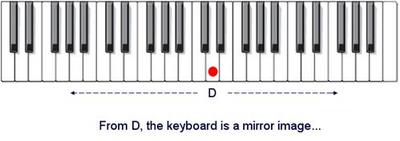
This yields the dorian intervals going up the scale from the D, w-h-w-w-w-h-w, and the same pattern going down from the pivot, w-h-w-w-w-h-w. It really makes navigation on the instrument a breeze. We're not talking about putting it on autopilot and playing junk - Rather, the predictability eliminates a lot of work. Perhaps we can refer to it as "Perceptual Economy", i.e., symmetry=simplicity, lack of symmetry=complexity.
And, as always, we can take this symmetrical pattern and move it all around the neck, move it over a string - We always "see" where we are all the time, and there's no energy spent figuring things out. We can just get down to the business of PLAYING.
Perceptual Economy. Another good reason to love this instrument.
Further:
Fretboard Geometry
More fretboard geometry--Maj7 arpeggios
The Seven Chord Naming Rules
The Theory of Available Tensions
Posted by Ted at 5:16 AM
 October 21, 2010 | More fretboard geometry--Maj7 arpeggios
October 21, 2010 | More fretboard geometry--Maj7 arpeggios
We mentioned the notion of geometric patterns on the mandolin fretboard in last week's Tips and Tricks column, "Fretboard Geometry." It's the idea that there are visual as well as tactile patterns we can use to incorporate in familiarizing the mandolin fretboard. One might even suggest the symmetry of the 5ths tuning almost makes it so simple, it's like we're cheating. Up frets, down strings, all over you have a block movability that's unsurpassed in other musical instruments. Why not take advantage?!
 One of the neatest tricks is in arpeggiated 7th chords. We'll look at a Maj7 in an exercise we've already made available here on the site in a moment. The simplest, most visual is starting it on your first finger. Next note is up four frets with your third finger. Move up a string and repeat it, and voila, Major 7th arpeggio. No matter where you put your first finger on the lowest three strings, you'll still be able to play a Maj7 arpeggio with this geometric shape. One of the neatest tricks is in arpeggiated 7th chords. We'll look at a Maj7 in an exercise we've already made available here on the site in a moment. The simplest, most visual is starting it on your first finger. Next note is up four frets with your third finger. Move up a string and repeat it, and voila, Major 7th arpeggio. No matter where you put your first finger on the lowest three strings, you'll still be able to play a Maj7 arpeggio with this geometric shape.
Why is this an important block? These are the meaty chord tones. When you are soloing, you want to know where they are. Conceptualize your soloing as this block of notes, and add the ones in between, above, and below. These are your temporary goals or resting points as you play them, and all the notes surrounding. When you move this geometric shape up the fretboard, you have this as your tactile rest stops, and your aural harmonic message.
Move it up!...
 
This is very easy to visualize, but it shouldn't be that much harder to take the same approach to starting a Maj7 arpeggio on a different finger. The following exercise does this, and gives you a chance to mix the FFcP patterns up a bit. Enjoy!
Download one page PDF:  Major 7th Arpeggios Major 7th Arpeggios
What we do in the GiJM book is take this a step further and drill three other chords, V7, m7, and m6. Notice how close they are visually. That should make the task of developing familiarity very efficient.
  
Have some fun with this! Bet you never thought geometry could be so fun...
Further:
Improvising: Throwing mud on the wall
Tetrachordal Approach to Major Scale Modes
Intentional Improvisation
Playing musically: Part 2, play the chords.
Posted by Ted at 2:03 PM
 October 14, 2010 | Fretboard Geometry
October 14, 2010 | Fretboard Geometry
Intellect. Touch. Space. Sound. Everyone attacks the way they master their instrument differently, utilizing these individual components of playing. Initially, most of us just feel the position of the finger or fingers on the strings, and hopefully, we're rewarded by a pleasant sound. As we progress, we start to notice relationships. These can be as complex as music theory, the mathematical relationships between notes and their function through time, or it can be as simple as the just the way the notes or chords feel after repetition in the fingers. Even the spatial relationships can register as a part of motor function and how the music feels in the hands.
We talk a lot about the theory behind the mandolin here on the site. The dirty little secret of our 8-string wonder is you can move similar patterns with ease because of the magnificent symmetry of the 5ths tuning. It's as much a function of geometry as anything, and we want to take a look at some simple visual patterns and how they can be repeated up and down the fretboard, and across strings. You might absorb this tactilely eventually too, but we've blocked out some graphics to assist demonstrating the concept.
The instrument is traditionally tuned in 5ths. This means open string pairs will give you the drone Perfect Fifth, but it also gives you the same pairs relationship as you close up the strings and move it up the fretboard. That Power Chord A5, A and E is simply two strings next to each other. Move it up five frets and you have a Power D5. Shift it across a string and you have an E5.
So what? This is in essence your 'I, IV, V' chord, repeatable in numerous keys and transpositions. Whole musical careers have been launched on little more than these chords, and you can do it with just one finger on the mandolin. The Power 5 chord is not just a Rock and Roll sound, it offers some delicious ambiguity in contemporary music, the with the lack of definitive "major-ness" or "minor-ness." It was also a big hit with the Gregorian Monks back in Medieval times.
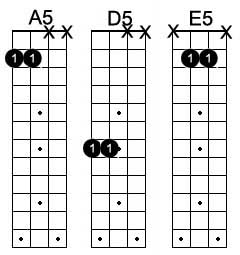
You can get a similar sound from its inversion, putting the 5th of the chord in the bottom, and the root at the top. This is also as important melodically as it is harmonically. Think of several tunes that start on the 5th of the scale, "Here Comes the Bride," "How High the Moon," "Ornithology," as examples. If you have identified the root of the scale or chord, the relationship on the fretboard is always the same, down a string, up two frets. That geometric relationship is a good trick to know. Now you have two notes you can immediately jump to when your improvising. It's just a matter of filling out the notes of the scale in between.
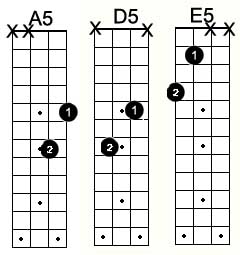
When we close in that two fret span to just one, we have an alluring aural treasure, the Tritone or the diminished 5th (#4). This is fretboard geometry you can exploit any time you play a Dominant 7th chord. It's the guts of the V7 chord, and powerful harmonic fodder. When you recognize and physically internalize this relationship, you can have all kinds of fun landing on it while improvising.
 
You can also slide it down some frets and develop a whole sequence of Circle of Fifths patterns. You don't need all four notes of the chord, these two are powerful enough on their own.
These are 5ths and 4ths, easily grasped on the mandolin fretboard, but you can also have some fun with 3rds. The following is a great little pattern you can move up and down in different keys and and harmony to your own melody. Notice graphically, sometimes there is a one fret span and sometimes there are two, depending on where you are in the scale. Getting to know where those are will give you some powerful tools for creating melody and harmony in almost any genre of music.
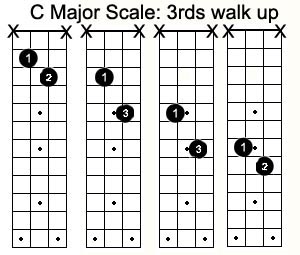
Many feared studying geometry in school, but ultimately found it useful in life, whether shopping for carpet or learning to parallel park. On the mandolin, geometry is your friend too. Use it as yet another tool for fretboard mastery.
Further:
GRIP #1
Mobility--chord transit
Two-chord jam; feed the beast.
Posted by Ted at 10:22 AM
 October 7, 2010 | The origin of a new string: D'addario FW74
October 7, 2010 | The origin of a new string: D'addario FW74
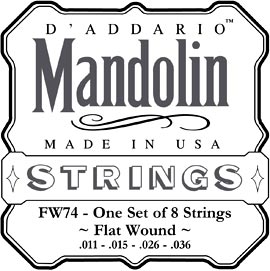 D'addario has just introduced a new flatwound mandolin string, and what is not widely known is the impetus and virtually all the intial design started right here with the research staff at JazzMando. We were already well into the successful development and marketing of the Labella JM11 strings, but felt the mandolin market needed a more worldwide distribution chain of economical flatwound strings. Labella was content to make us the wholesale distribution, and we just didn't want to take on that responsibility. D'addario has just introduced a new flatwound mandolin string, and what is not widely known is the impetus and virtually all the intial design started right here with the research staff at JazzMando. We were already well into the successful development and marketing of the Labella JM11 strings, but felt the mandolin market needed a more worldwide distribution chain of economical flatwound strings. Labella was content to make us the wholesale distribution, and we just didn't want to take on that responsibility.
We were already experimenting with the D'addario chrome series electric guitar single strings on the Epiphone Mandobird and found these strings to be effective on an acoustic mandolin when the balls were removed. We experimented with gauges and discovered we did not have to stray too far from what was working on the JM11s. In essence, D'addario was already making the FW74, it was a matter of making them with loops instead of balls.
We met with the marketing department three years ago to pitch the idea. Keep in mind a thriving company like D'addario always has projects on the drawing board for a huge number of stringed instruments, from electric guitar to ukulele, to oud, and once we sold them on the idea, it took many months to actually make it into development. It wasn't as simple as taking the balls off, they had to rework production, because winding a loop end string is still wound differently in manufacturing.
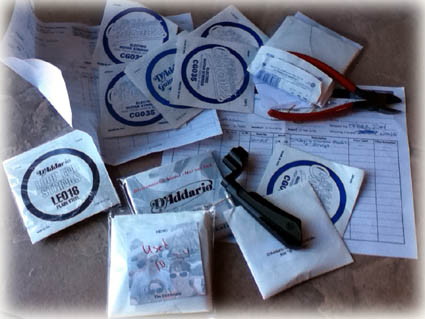
We wanted to see if they could reduce the cost and the inflexibility of playing area length by removing the silk wrapping found on the Labella and Thomastik strings. (Labella requires them in their process.) We found some tailpieces prevented the JM11s from working on all mandolins, and we wanted to remove that barrier with extra length. Unfortunately, it appears the cost savings is not drastic on these, as street pricing is landing in the same range as the Labella, still virtually half the cost of the Thomastik.
FAQ:
Who will be using these?
Flatwound strings are great for closed position fingering, something we advocate strongly. Classical, jazz, and more advance folk playing in the upper frets are arguably more comfortable with these strings, and reducing fatigue in the lower. The tigher wrap also produces more string fundamental, at the expense of bright zingy overtones. These are not a "drone" string, rather they are meant to be played in complex chromatic passages with smoothness and ease.
How much are these in comparision to other flatwound strings; why are they so expensive?
One misconception we need to address is the cost. In actuality, you should get anywhere from two-four times the play out of these with the corrosion resistant tighter winding. This means like the EXP series, if the cost is twice as much, you're getting more life at the same value. (Street price generally $13-15 depending on shipping.)
Are these meant to replace the Thomastik TI series?
Our goal was to come up with a string that was about 1/3 the price and we didn't quite make that. They will be about half, though. They aren't the same string. Some may argue they aren't as rich or warm, but many will like the fact that they actually pack more "ping." In the tonal spectrum, they are closer to sounding like a roundwound string, but maintain the flatwound feel.
Is the A flatwound?
This is a personal preference, and cost issue. Initially we wanted to keep the price down, but we have been prototyping an wound 17 gg string. That's still a little heavy for this set, but they might be available as singles. For now, the FW74 have a plain A string. This worked fine for the majority of our thousands of JM11 customers.
Is this the only gauge they come in?
Initially, we proposed three different sets. We wanted a medium set and a medium light mandolin, but more importantly we wanted an octave mandolin/mandola set. The marketing department wanted to move a little more slowly by introducing one unit at time. This was the compromise, but we hope the other two will come along as these prove market viability.
Do you plan to discontinue the Labella JM11?
Despite the attempts to make this like the JM11 strings, they simply aren't the same. They're not better, not worse, just a tad different. Yes, we've had some issues with E loops, D string cores, and winding lengths, but this three centuries-old company is still run by a family, and each situation was graciously remedied promplty without question and free replacements directly from Labella. The JM11s have the silk winding for locking down in the tuners more quickly, and they still have a bit more complex warmth. With our free shipping, they will probably be the same price as the FW74 if you only order a couple sets at a time and don't need to add more items to your online shopping cart. Frankly, we don't expect the FW series to affect JM sales. We even encourage our existing customers to experiment.
Understand, we have no financial involvement with D'addario Strings, no royalties, no commissions, no consulting fees. Not even free strings. Our goal on this whole project was to make more manufaturers aware of the growing need for the availibilty of flatwound strings. We talked with other string makers, specifically DR Strings, GHS, and Dean Markley, and no one but D'addario would tackle this project. We're already experimenting with other gaugings, including a wound 17 and wound 13, but there's always a distance in time between prototyping and market introduction. Again, our biggers concern is the gap in octave mandolin and mandola strings. We think we have a solution in a set that will fit both instruments, but D'addario needs confidence in their viablity.
We're open to your suggestions. Understand there is no single set that will make everybody happy, but we want to accommodate a broad range of preferences. The FW74 is just the beginnning.
Special thanks to the staff and crew that helped test these, Charlie, Jamie, Barb, Terry, David, and Levi.
Further:
Build your own flatwound string sets
Posted by Ted at 8:21 AM

Disclaimer: In the 'Information Age' of the 21st Century,
any fool with a computer, a modem, and an idea can
become a self-professed 'expert." This site does not
come equipped with 'discernment.'
|



